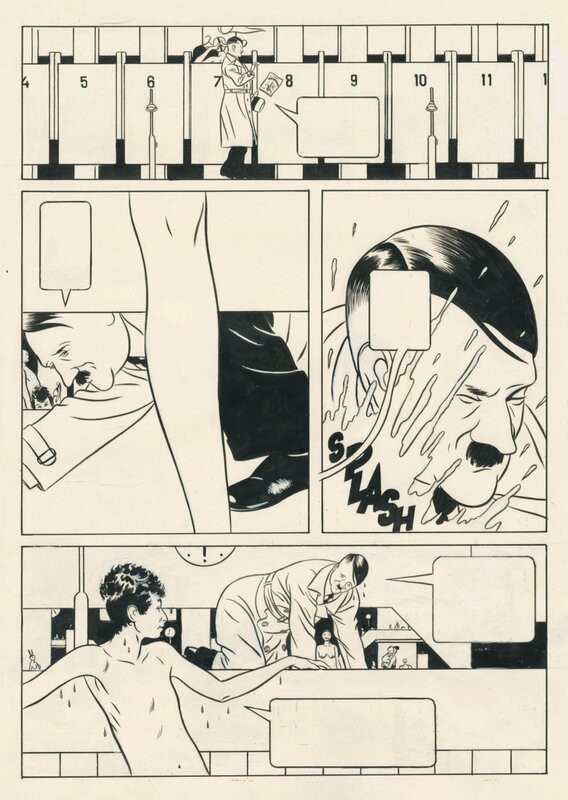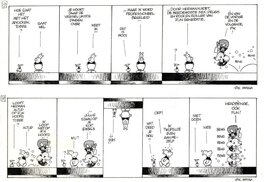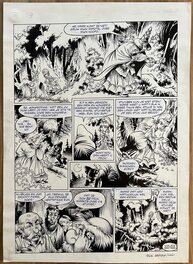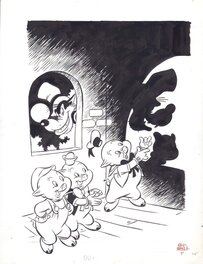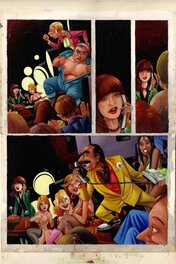In ArieK 's collection
1981 - Mythen / Mythes - Bob Dylan - Judgment day / Heavy Metal (Page - Dutch KV)
Ink
Added on 2/12/18
Link copied to clipboard!
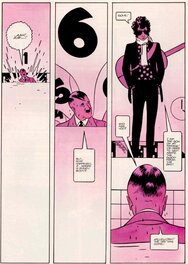
Comment
Dick MATENA - born 1943 - The Netherlands
Mythen
Page - Ink on paper - 42x30 cm
Publication in Dutch book 1984.
From: http://arche-arc.blogspot.nl/2011/05/heavy-metal-september-1981.html
PLOT-SUMMARY
for “Judgment Day:” A man who looks like Adolf Hitler, but who is referred to as “Judas Priest,” is hawking copies of the Jehovah’s Witness publication THE WATCHTOWER in a surrealistic bathhouse. Judas spouts hyperbole about all the sinners who will face “eternal shame and tears” when the Son of God returns, but while doing so he peeks at the bathing women. Judas is mocked for his hypocrisy by a young male bather, Frankie Lee, identified as a “carpenter whose father is deceased.” Frankie tempts Judas by telling the roué that Frankie’s father left him a house full of prostitutes. Judas gives Frankie money but an (apparently) female bather approaches Judas and shocks him by showing off “her” dick. Retreating, Judas falls into the swimming pool. He sinks so deep that a submarine, commanded by a “Monsieur C,” spots him. Judas returns to the pool’s surface but now the bathhouse is almost empty, save for a youth with a guitar on his back. He claims to be “the son of my father,” who is “here to separate the good from the bad.” Judas follows the stranger to “the place from where everybody will leave to stand trial.” Judas witnesses half-naked guards in Nazi costumes attacking people at the place of trials. Then the “son” guides Judas to a train with a cattle-car containing “some of my father’s favorites.” When Judas gets in, he sees that the car is full of dead bodies. The son shuts Judas in, telling him that the corpses are alive now, because “I just woke them.” Story ends with Hitler/Judas about to get his reward.
MYTH-ANALYSIS: If one wishes to reduce Dutch artist Dick Matena’s 8-page story to its most basic level, then it’s a “Kill That Nazi One More Time” story. Given the real-world death of Adolf Hitler, more realistic stories in this vein, such as Krigstein’s celebrated “Master Race,” can only vent their wrath on Nazi subordinates who escaped war crimes trials. However, tales with greater fantasy-content can bring back the Fuhrer himself in one form or another, either by the SF-device of saving his brain or even telling an alternate history where Hitler gets killed in a more satisfying fashion (i.e., Tarantino’s INGLORIOUS BASTERDS).
By the title alone, it’s clear that Matena is frying up larger fish. The Christian religion’s emphasis upon sorting out “the good from the bad” in preparation for the Day of Judgment is conflated with the Nazi policy of sorting out the various undesirables that supposedly polluted German purity. Race and religion were the pollutants most often cited, but Nazism also reviled things having nothing to do with heritage, such as mental retardation and sexual deviance. Signficantly, though the corpses in the cattle-car reference the fate of prisoners shipped to concentration camps, Matena’s Judas does not inveigh against race or religion: only against the things considered sinful by Christian religion. Despite the specific reference to Jehovah’s Witnesses I don’t think Matena is singling out that particular sect: all Christians who base their ethics in the sorting-out of a “Final Time” are implicated in Matena’s comparison between Christianity and Nazism.
To be sure, it’s an implication steeped in comic irony. The image of Hitler selling copies of the WATCHTOWER is a very funny image, even before one knows where Matena’s going with the idea. Still, Matena does develop the idea, in contrast to occasional bits of toss-off surrealism, like the three-panels with the submarine in the swimming pool. One assumes that the “Monsieur C” running the submarine is a doppelganger for Jacques Cousteau, but he’s probably not in the story for any reason beyond brief amusement.
Mythen
Page - Ink on paper - 42x30 cm
Publication in Dutch book 1984.
From: http://arche-arc.blogspot.nl/2011/05/heavy-metal-september-1981.html
PLOT-SUMMARY
for “Judgment Day:” A man who looks like Adolf Hitler, but who is referred to as “Judas Priest,” is hawking copies of the Jehovah’s Witness publication THE WATCHTOWER in a surrealistic bathhouse. Judas spouts hyperbole about all the sinners who will face “eternal shame and tears” when the Son of God returns, but while doing so he peeks at the bathing women. Judas is mocked for his hypocrisy by a young male bather, Frankie Lee, identified as a “carpenter whose father is deceased.” Frankie tempts Judas by telling the roué that Frankie’s father left him a house full of prostitutes. Judas gives Frankie money but an (apparently) female bather approaches Judas and shocks him by showing off “her” dick. Retreating, Judas falls into the swimming pool. He sinks so deep that a submarine, commanded by a “Monsieur C,” spots him. Judas returns to the pool’s surface but now the bathhouse is almost empty, save for a youth with a guitar on his back. He claims to be “the son of my father,” who is “here to separate the good from the bad.” Judas follows the stranger to “the place from where everybody will leave to stand trial.” Judas witnesses half-naked guards in Nazi costumes attacking people at the place of trials. Then the “son” guides Judas to a train with a cattle-car containing “some of my father’s favorites.” When Judas gets in, he sees that the car is full of dead bodies. The son shuts Judas in, telling him that the corpses are alive now, because “I just woke them.” Story ends with Hitler/Judas about to get his reward.
MYTH-ANALYSIS: If one wishes to reduce Dutch artist Dick Matena’s 8-page story to its most basic level, then it’s a “Kill That Nazi One More Time” story. Given the real-world death of Adolf Hitler, more realistic stories in this vein, such as Krigstein’s celebrated “Master Race,” can only vent their wrath on Nazi subordinates who escaped war crimes trials. However, tales with greater fantasy-content can bring back the Fuhrer himself in one form or another, either by the SF-device of saving his brain or even telling an alternate history where Hitler gets killed in a more satisfying fashion (i.e., Tarantino’s INGLORIOUS BASTERDS).
By the title alone, it’s clear that Matena is frying up larger fish. The Christian religion’s emphasis upon sorting out “the good from the bad” in preparation for the Day of Judgment is conflated with the Nazi policy of sorting out the various undesirables that supposedly polluted German purity. Race and religion were the pollutants most often cited, but Nazism also reviled things having nothing to do with heritage, such as mental retardation and sexual deviance. Signficantly, though the corpses in the cattle-car reference the fate of prisoners shipped to concentration camps, Matena’s Judas does not inveigh against race or religion: only against the things considered sinful by Christian religion. Despite the specific reference to Jehovah’s Witnesses I don’t think Matena is singling out that particular sect: all Christians who base their ethics in the sorting-out of a “Final Time” are implicated in Matena’s comparison between Christianity and Nazism.
To be sure, it’s an implication steeped in comic irony. The image of Hitler selling copies of the WATCHTOWER is a very funny image, even before one knows where Matena’s going with the idea. Still, Matena does develop the idea, in contrast to occasional bits of toss-off surrealism, like the three-panels with the submarine in the swimming pool. One assumes that the “Monsieur C” running the submarine is a doppelganger for Jacques Cousteau, but he’s probably not in the story for any reason beyond brief amusement.
To leave a comment on that piece, please log in
About Dick Matena
Dick Matena is one of the most versatile and productive comic authors of The Netherlands. He has worked anonymously on comics with other people's creations (Marten Toonder, Walt Disney), wrote and drew popular children's and adventure series for most Dutch comic magazines, published more adult-oriented and artistic stories in internationally renowned magazines, and gained nationwide attention with his adaptations of famous Dutch literary works and children's books. Because of these adaptations, Matena broke out of the Dutch comics scene and also became a well-known figure within literary circles. He furthermore worked for Toonder, Donald Duck weekly, the 'Rooie Oortjes' collection and the Dutch space opera 'Storm' (with art by Don Lawrence). His best known original creations are 'De Argonautjes' (1968-1973), 'Ridder Roodhart' (1969-1971), 'Grote Pyr' (1971-1974) and 'Virl' (1977-1981, 2011-2012).
Text (c) Lambiek

